The battle to separate Safa and Marwa
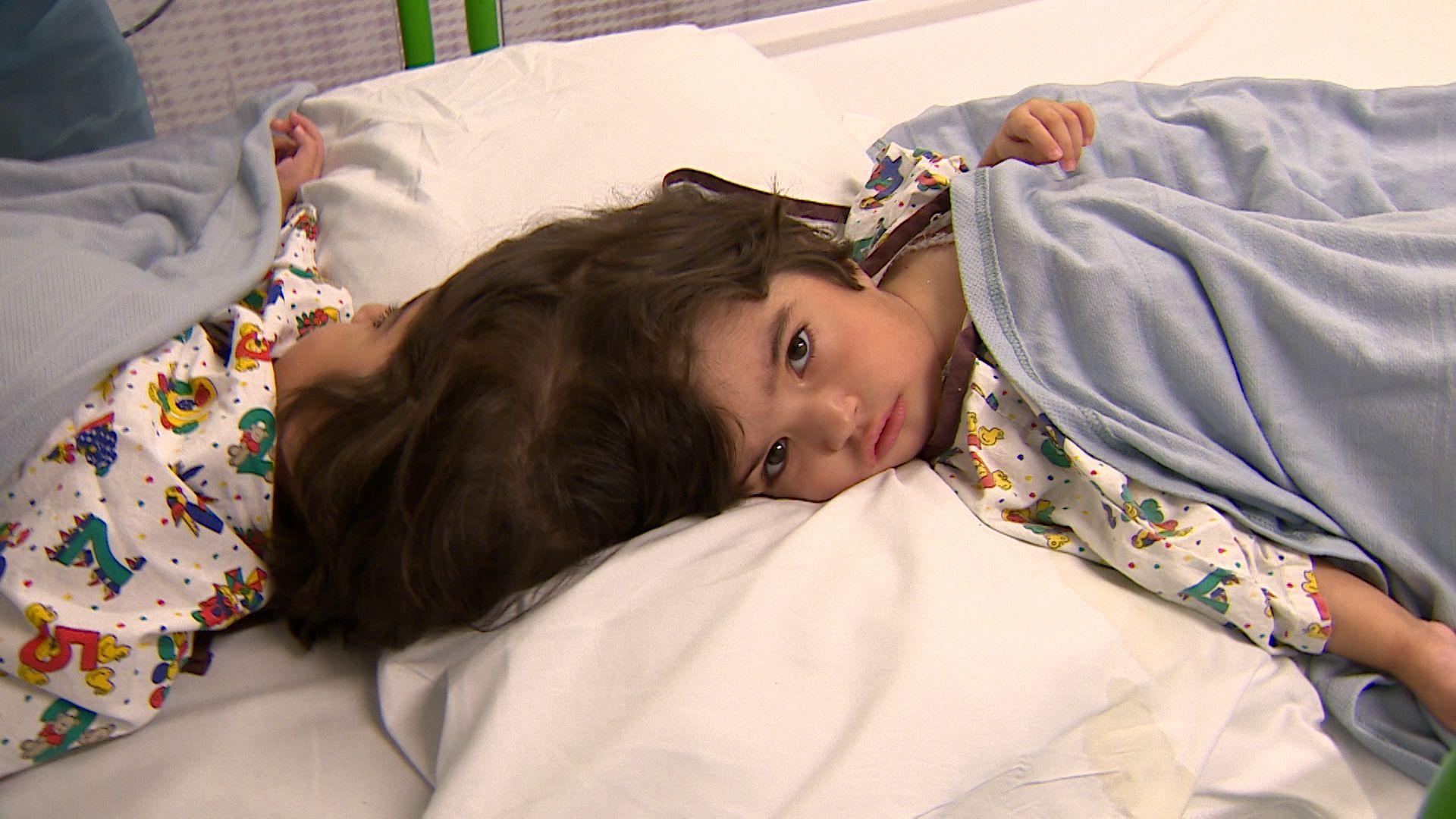
It’s the rarest form of a rare condition - conjoined twins, fused at the head.
The BBC has been granted exclusive access to a ground-breaking series of operations in a British hospital to separate two sisters.
There is a crowd in the operating theatre. But the team of nearly 20 works as one.
Moving smoothly, every motion calculated. No signs of stress or tension, just hands methodically performing tasks.
But this is no routine operation. The shrouded shape of two small girls is picked out by the bright theatre lights. Safa and Marwa are joined at the head. Their brains are exposed as the surgeons work to separate a labyrinth of shared blood vessels.
But then the calm and peace of the theatre disappears, as anaesthetists raise the alarm.
The blood from Safa’s brain isn’t draining properly and she is shunting blood to her sister.
This puts strain on Marwa’s heart and she becomes dangerously unstable.

The anaesthetists call out commands, report vital signs and busy themselves trying to stabilise the girls.
"I think we need to shock," says one of them.
Pads are attached to Marwa’s chest in preparation.
The lead surgeon raises both hands so they can be clearly seen, and steps back.
Then everyone waits.
If they lose her, they may also lose Safa.
The birth
Zainab Bibi has already given birth to seven children - all of them at home. So when she becomes pregnant with twins, the plan is to do the same thing.
But after an ultrasound scan picks up a complication, she is advised to have them delivered in hospital.
It’s a difficult time for the family. Two months before the birth, Zainab’s husband died of a heart attack.
She is also told by the maternity team that the twins might be joined together. But there has been no mention of where on their bodies the join might be.
No-one, it seems, realises the full extent of the complications to come.

On 7 January 2017, the twins are delivered by Caesarean section at Hayatabad hospital in Peshawar, some 31 miles (50km) from her home in northern Pakistan.
The family are told that the girls are healthy.
But Zainab doesn’t meet the newborns immediately, because she needs to recover from the surgery.
It is the twins' grandfather Mohammad Sadat Hussain who finds out the truth first - the girls are what is called craniopagus twins, which means they are joined at the head. It is the rarest form of what is already a rare condition.
Their grandfather arrives on the maternity ward bearing the traditional gift of sweets for the nurses.
Still in mourning for the loss of his son, meeting his granddaughters is a bittersweet moment: “I was happy to see them, but I was thinking what am I going to do with them because of their joined heads?”
It is five days before Zainab is well enough to be introduced to her daughters, and she is given a photo of the twins to prepare her.
She says she instantly fell in love.
“They were very beautiful and they had nice hair with white skin. I didn’t even think about the fact they were joined. They are God-given.”
They are named Safa and Marwa, after the twin hills in Mecca, Saudi Arabia, that play a central role in the Islamic ritual pilgrimage of Hajj.
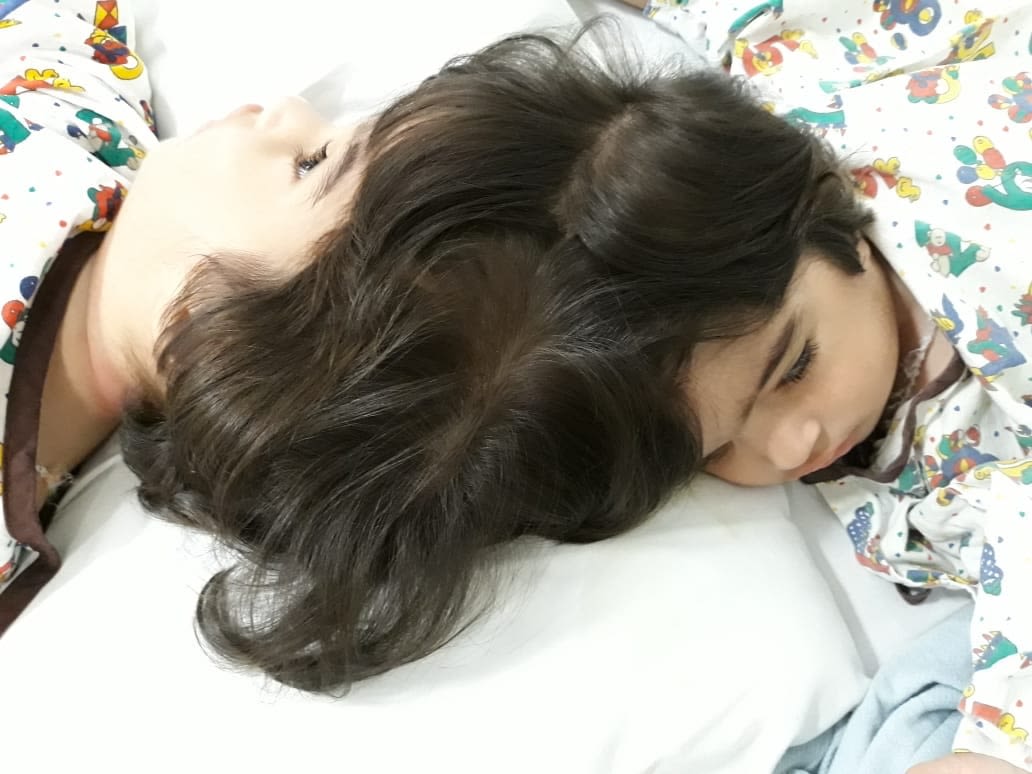
After a month, the twins are discharged from hospital and the family agree that if it can be done, they should be separated.
A military hospital offers to perform the surgery but warns that one of the twins is likely to die. It is a risk their mother is unwilling to take.
Other options are explored, and when the twins are three months old, the family are put in touch with Owase Jeelani, a paediatric neurosurgeon at one of the world's leading children's hospitals, Great Ormond Street in London (GOSH).
By coincidence, he was born in the nearby region of Kashmir and immediately establishes a rapport with them.
After seeing scans of the girls, the surgeon is convinced they can be safely separated, but he wants to do it before they reach 12 months old, to get the best outcome.
The clock is ticking.
It is August 2018. The visas for the UK have already come through, but funding for the operations has not. This is not something the NHS in the UK would fund and Jeelani has raised only a small amount of the money needed to pay for the hospital care.
The girls are now 19 months old, well beyond the age that the GOSH team would like to operate. Any further delay might mean the separation becomes more dangerous, recovery more limited.
Jeelani urges the family to come to England immediately.
He remembers the moment they arrived: “They turned up in early August and at this point we only had a small amount of the money we needed. The kids were here and I must say I was really stressed. At this stage it felt like a personal responsibility.”
The twins’ uncle Mohammad Idrees and their grandfather are put up in a flat near the hospital. But Zainab will not be parted from her daughters, and prefers to sleep in their room.
Despite being joined, the twins have distinct personalities, according to their mother.
Safa, is “smart, happy and talks a lot”. Marwa, on the other hand, is shy. “She sometimes talked to herself but when we spoke to her she didn’t always reply,” says Zainab.
Shortly after their arrival, while Jeelani is having lunch with a lawyer friend, a moment of pure serendipity changes everything. After he tells her the story of the twins, the lawyer picks up her mobile phone and makes a call.
The surgeon is asked to tell the person on the line about the girls. He is speaking to a wealthy Pakistani businessman, Murtaza Lakhani. Within a few minutes, an offer has been made to meet the costs of their treatment.
“The twins are from Pakistan which is where I am from originally,” says Lakhani.
“However, the true reason for me helping them was because it was an operation that was going to save the lives of two children. For me it was an easy decision, it’s how you build the future.”


Fused together
Conjoined twins develop from one fertilised egg and so are always identical.
There are two theories about why they are fused together - either the split into two embryos happens later than usual, and the twins only partially divide, or, following the split, parts of the embryos remain in contact and those body parts merge as they grow.
When it occurs, twins are more commonly connected at the chest, abdomen or pelvis.
Safa and Marwa’s particular commingled physiology presents a unique set of challenges for the GOSH team. The girls are joined at the top of their heads - crown to crown - facing opposite directions.
They have never seen each other’s faces.

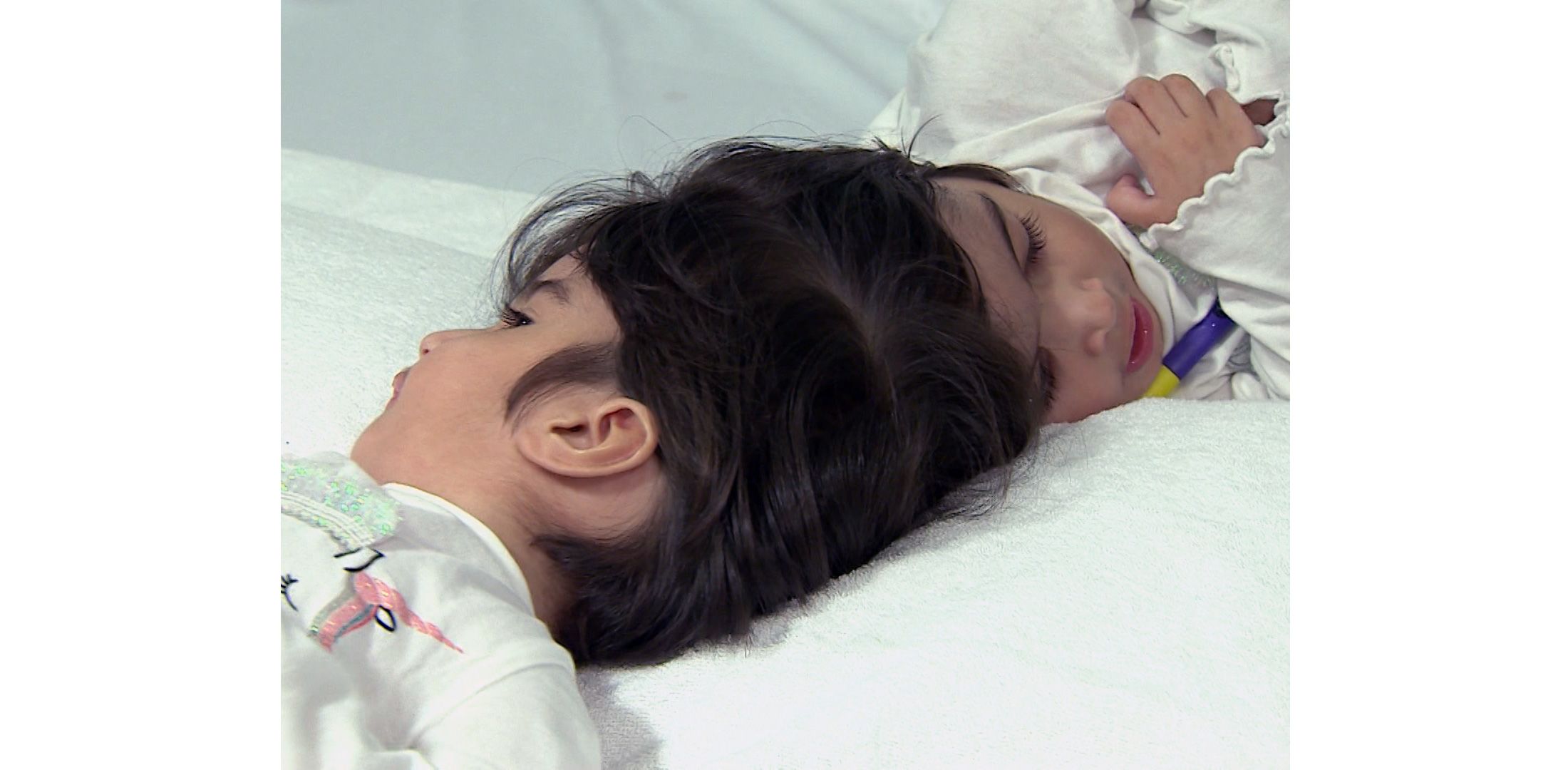
Their skull is like a stove pipe, a long straight tube. Scans show that the girls have two distinct brains but these are misshapen. The right hemisphere of each brain is sticking up 90 degrees, projecting into the other twin's brain cavity.
This distorted shape will need correcting if the girls are to have near normal-shaped heads.
The surgical team's biggest concern is how to separate the complex shared network of veins and arteries. Each twin supplies the other with blood. Severing these connections carries a risk of starving the brain of nourishment and causing a stroke.
There are no official figures for the prevalence of craniopagus conjoined twins, but one estimate puts it at one in every 2.5 million births. Most do not survive beyond 24 hours.
Each case is unique, and separations of craniopagus twins have only been reported about 60 times since the first attempt in 1952.
Jeelani believes there could be up to six sets of craniopagus twins born worldwide each year who might be successfully separated.
Great Ormond Street Hospital is a world leader in this kind of surgery. Safa and Marwa will be their third set of craniopagus twins, more than any other centre. The team knows from experience that the best outcomes happen when the separation is staged over several operations, to allow for recovery in between.
As well as surgeons and nurses, the 100-strong team at GOSH involved with the care and separation of the twins includes bio-engineers, 3D modellers and a virtual reality designer.
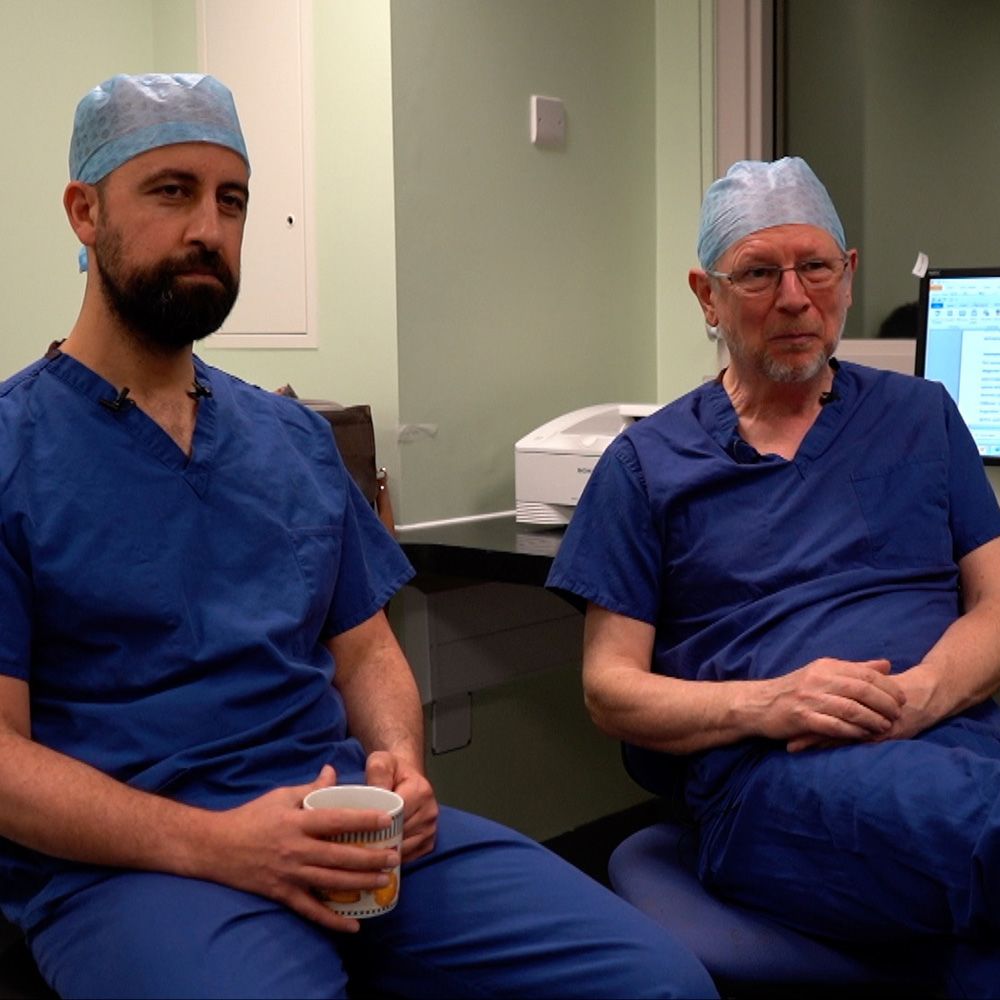
Owase Jeelani and Prof David Dunaway
Owase Jeelani and Prof David Dunaway
Jeelani will take the lead in separating the girls' brains and blood vessels, but it will be plastic surgeon Prof David Dunaway who will be responsible for rebuilding the girls' heads, and giving each of them a top to their skulls.
First operation
It's 08:00 on Monday 15 October 2018, and a team of nearly 20 gathers in theatre 10 at GOSH. Each member of staff identifies themselves and what their role will be.
"We have one case for the list today. Safa and Marwa. Two kids, one case," says Jeelani.
The twins’ slow journey to independence is about to begin.
The aim of this surgery - the first of three major operations - is to separate the twins' shared arteries.
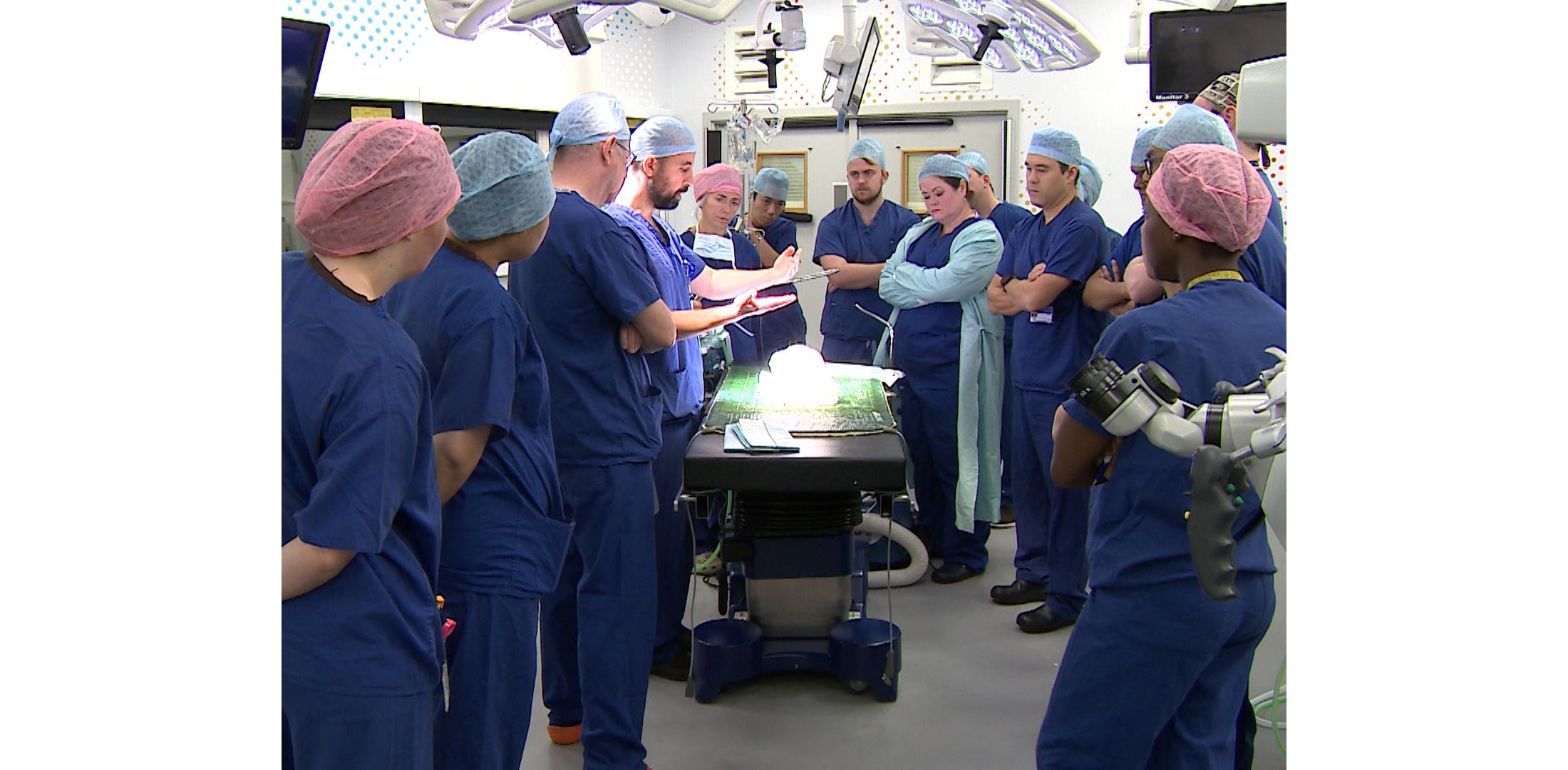

Jeelani works his way through the plan one last time but everyone knows what they have to do. The team has been preparing for this day for months.
"We have been through everything in fine detail - rehearsed it repeatedly. This is the moment of truth and everything has to be perfect," says Dunaway.
Meanwhile on Bumblebee ward, the twins are being readied for theatre. Wearing identical surgical gowns, Safa and Marwa cry and twist restlessly.
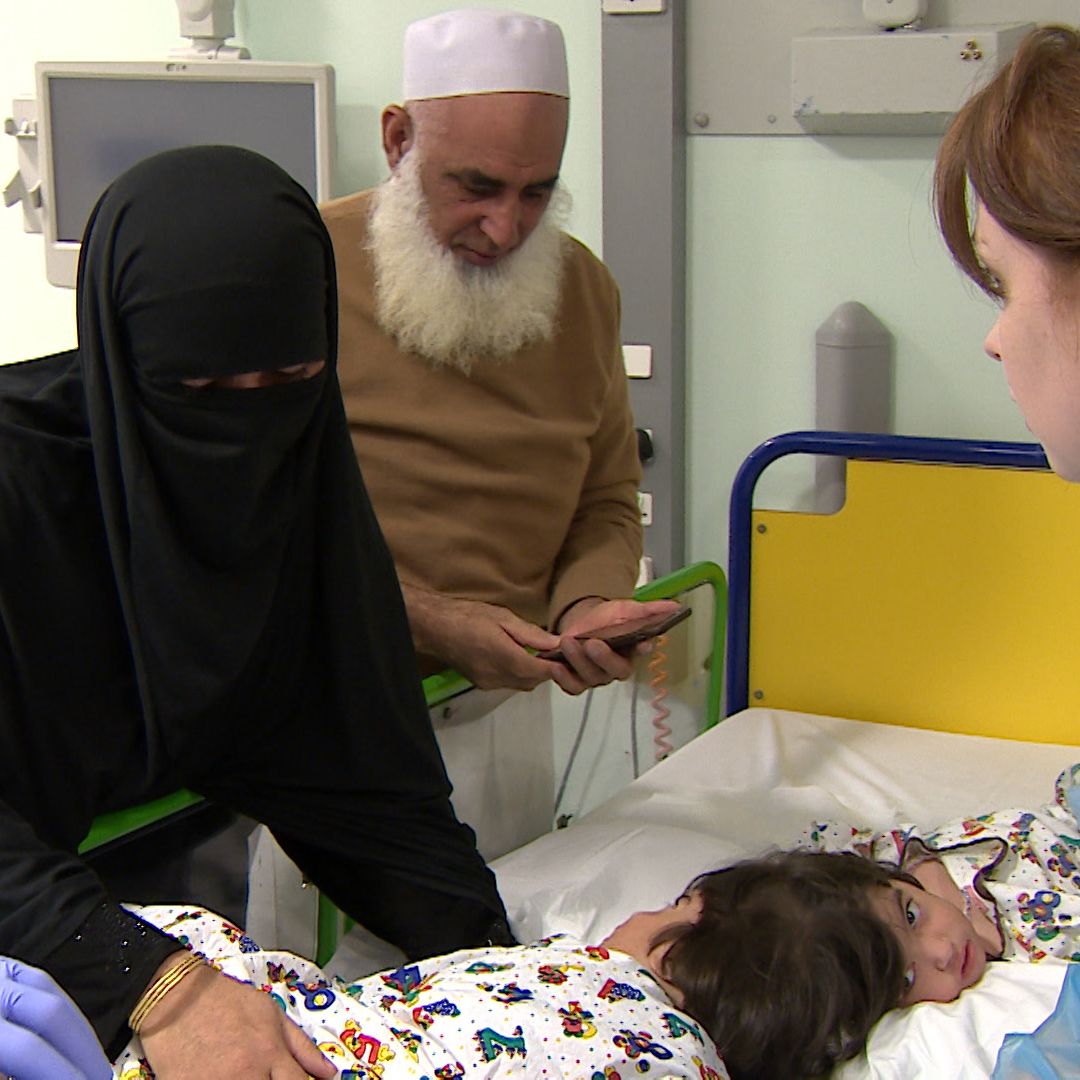
Separating conjoined twins carries huge risks. One or both could die during surgery or be left with brain damage. The family understand the dangers, and have complete trust in the team.
“It is clearly very difficult to go through life when you are joined together like that, so it does make a persuasive case in favour of attempting the separation and the family are very clear on that,” says Jeelani.
Dunaway says the team has carefully assessed the ethical issues.
“Clearly I think life being separate is better than being joined together. If we felt there wasn't a very high chance that we could do it safely, we would think hard about whether we should do it at all. The whole team feels there's an excellent likelihood of a successful separation here.”
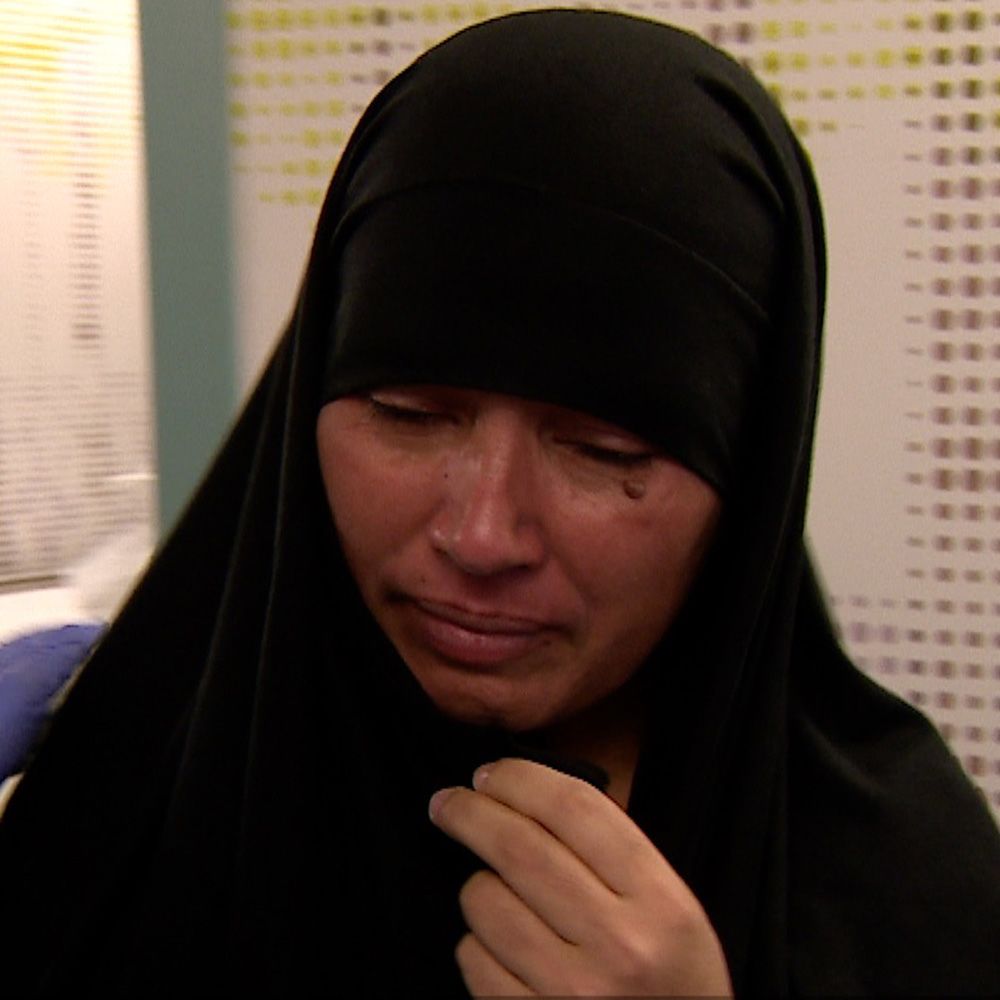
As the twins’ trolley arrives at the theatre doors Zainab kisses her daughters. She knows the coming months will be hard on them and the emotion of parting is overwhelming. In tears, she is comforted by one of the many nurses she has come to look on as family.
"I am hopeful that everything will be okay and I have full trust in the doctors. I always look to God - he will make everything great," she says.
In theatre, the first task is to remove three large segments of skull.
Jeelani is wearing surgical loupes, glasses fitted with magnifying scopes. He follows the marks he traced on the girls' shared skull, now shaved, and cuts through skin and bone.
Once the brains are exposed he swaps his surgical loupes for something far more powerful.
Standing 7ft high, the operating microscope dominates the theatre. It allows the neurosurgeon to examine the microstructure of the twins’ blood vessels.

It's now 14:30 and Jeelani announces: "The artery from Safa going to supply Marwa's brain has been clamped. Now we wait."
It’s a dangerous moment. Every time a connection is cut, there is a risk of brain damage. After five minutes the surgeon says the brain "doesn't look like it is too bothered", and carries on.
This painstaking procedure continues for several more hours as the shared arteries carrying oxygenated blood from one twin to the other are clamped and sealed.
Meanwhile, a second team, led by Dunaway, has set up shop a few feet from the main action.
Their task is to create a rigid frame from the three sections of skull, which can be detached in subsequent operations.

The curved bone pieces are held together with a network of metal mesh and screws.
Dunaway says this is a particular challenge given the twins' age: “Being older they are pretty active and so whatever we do has to be strong enough to resist the twisting and bending forces they will be putting on their heads."
As the team patiently tease Safa’s and Marwa's brains apart, they feed in a sheet of soft medical plastic to stop them reconnecting in between operations. A pulley system has been secured to the plastic to counteract the way a part of each brain sticks up into the other twin's skull. This will gradually ease the brains back into place.
Once the shared arteries are separated, the skull frame is re-attached. The operation has lasted 15 hours.
The girls are taken to intensive care. After two days, they are sent back to their usual home on Bumblebee ward - things are looking good.
State-of-the-art technology
Jeelani and Dunaway were both involved in the separation of craniopagus twins at GOSH in 2006 and 2011.
The latter involved Rital and Ritaj Gaboura, twin girls from Sudan who were 11 months old.

Rital and Ritaj Gaboura
Rital and Ritaj Gaboura
Dunaway says the separation of Safa and Marwa is by far the hardest, not least because of their distorted brain shape.
"The first two cases were much more straightforward and we were lucky. But with this set we underestimated the complexity of the oblique brain joining. Also, they are older and I think older is really bad news."
The surgeons believe the ideal time for separating craniopagus twins is when they are between six and 12 months old.
"We put these twins through a lot," says Jeelani. "Younger brains and younger circulations have better regeneration potential."
Dunaway agrees: "Everything is easier. The skin stretches and heals better and the bone grows in better."
Safa and Marwa are nearly two, but while their age is against them, the team does have some elements working in their favour. Imaging and modelling technology have advanced significantly in the past eight years, which has helped them plan the separation in greater detail than ever before.
In a narrow, cramped office dominated by a huge curved computer screen, sits craniofacial plastic surgeon Juling Ong. He is heading the modelling team for Safa and Marwa’s separation and demonstrates some of the cutting-edge systems they now have at their disposal.
"These are really unique cases and it's not something that we get taught in medical school,” he says. “With this software, we can make a realistic computer model to look at the extraordinary anatomy of these children and plan our surgeries beforehand."
On the screen he displays some stunning 3D models of the girls’ skin, skulls and interlocked brains that have been made from traditional scans. "It allows us to try out different strategies for operating, and the likely danger areas given the twins’ unique anatomical structures.”
But these computer models don’t just stay on a screen, they can also take on a physical shape thanks to a 3D printer.
Forty-eight hours later, the hospital’s 3D technician Kok Yean Chooi pulls out a shapeless looking lump of soft plastic. As he scrapes and washes the excess material away, a likeness emerges of one twin's skull cavity and skin envelope. This replica is to help plan how the layer of skin between the girls' shared skull will be divided.
Many of these 3D models have been created, allowing the surgeons to explore the twins' unique anatomy, long before scalpel touches skin.


"To be able to see and visualise this and play with these models before the surgery makes an enormous difference to how we plan and do this operation,” says Jeelani. “What we need to achieve is, in effect, to sort of untwist the brains. And that's pretty difficult to do just in your head."
Dunaway agrees: "We've spent a lot of time just sitting looking at these models and going through the ‘what ifs’".
But the team has gone beyond physical models. Wearing a virtual reality visor and gripping a pair of controllers, Jeelani sits in front of a computer screen, rocking from side to side. He keeps repeating the same word: "Incredible."
The surgeon has been transported into a virtual world which allows him to explore the twins' intermingled vascular system.
“This is clearly the way of the future,” he enthuses. “We are blessed here [at GOSH] in terms of the engineers and the software specialists - the skill sets they bring to the equation are skills that we as doctors with our medical training don't have.”

Difficult decision
The second operation takes place one month after the first. While the first surgery sealed off the twins’ arterial connections, today's task is to divide the shared veins that drain blood from the girls' brains. Every severed connection runs the risk of causing a stroke in one of the twins.
This time things are not going smoothly.
As soon as the skull frame is detached, the girls start to bleed. Since the last operation clots have formed in Safa's neck veins. They are restricting drainage of blood from her brain so she is constantly shunting blood to Marwa instead. One twin’s blood pressure goes sky high, while the other’s dips dangerously low.
The anaesthetists are struggling to keep them stable.
That's when Marwa's heart rate plummets and they fear she may die on the table.
There is suddenly quiet and stillness around the operating table as all eyes are on the instrument screens. The only sounds are the accelerated beeps of the heart monitors.
The crisis passes, but not without serious consequences.
It is clear to the surgical team that Marwa is the weaker twin. So they decide to give her a key shared vein. It will increase her chances of survival.
It is a hugely difficult decision. Jeelani knows that it may have a serious impact on Safa, until now the stronger twin.
But the team agrees that it is the right thing to do. The operation lasts more than 20 hours. Jeelani is exhausted and hands over to plastic surgeon Juling Ong to close.
"I am relieved. We thought we might lose Marwa at one point,” he says. “But if they wake up as we hope they will, it's gone well."
The surgeons leave theatre at 06:30 the next morning.
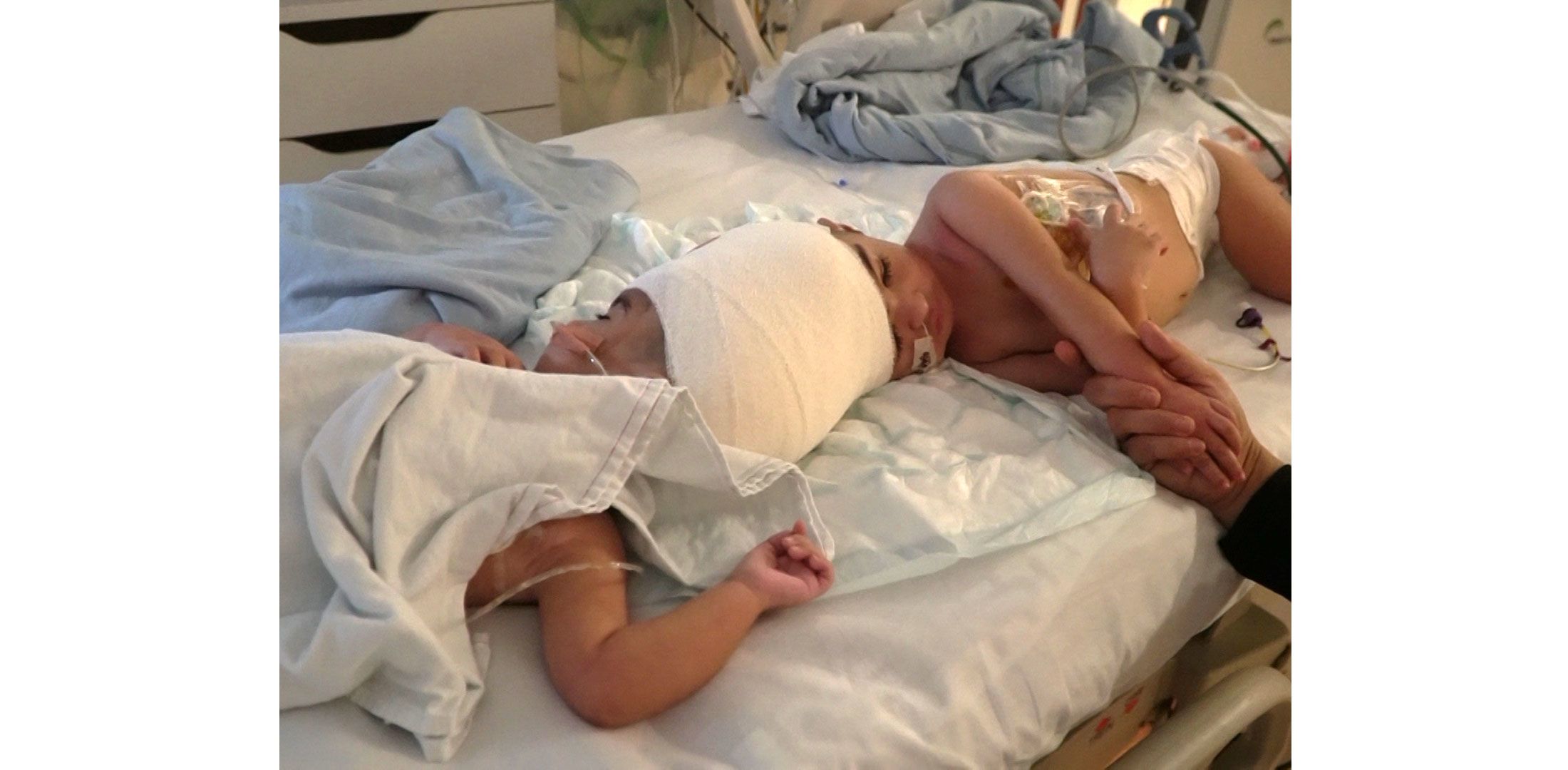
In the late afternoon, Jeelani telephones the hospital from home to check on the girls. He is told that Safa is in trouble, making no effort to breathe and her skin is mottled.
"I thought, ‘Safa is dead’," he says, and recounts how, emotionally exhausted and sleep-deprived, he collapsed on his kitchen floor and started to cry.
"My poor wife had never seen me like that before. She gave me my phone and said: 'Call David'.
“You're invested so heavily in the twins and also so physically tired at this stage, you have very little reserves left,” he explains. “So it becomes much harder to deal with, with emotional ups and downs and complications."
Both surgeons return to intensive care and examine a CT scan of Safa's brain.
What they feared has happened. She has had a stroke in the area of the brain where they gave the key vein to Marwa.
Over the next two days, Safa is in a critical condition.
Zainab, her brother and father-in-law, pray by the twins' bedside.
Eventually, Safa shows signs of recovery. Both twins are weaned off ventilators and are able to breathe on their own. The surgeons begin to relax.
Nonetheless, as a result of the stroke Safa has some weakness in her left arm and leg.
This weighs heavily on Jeelani’s conscience. "For me the big moment is going to be when she walks and when she uses her left arm properly, because I know I've given her that weakness and for me that's a hard thing."



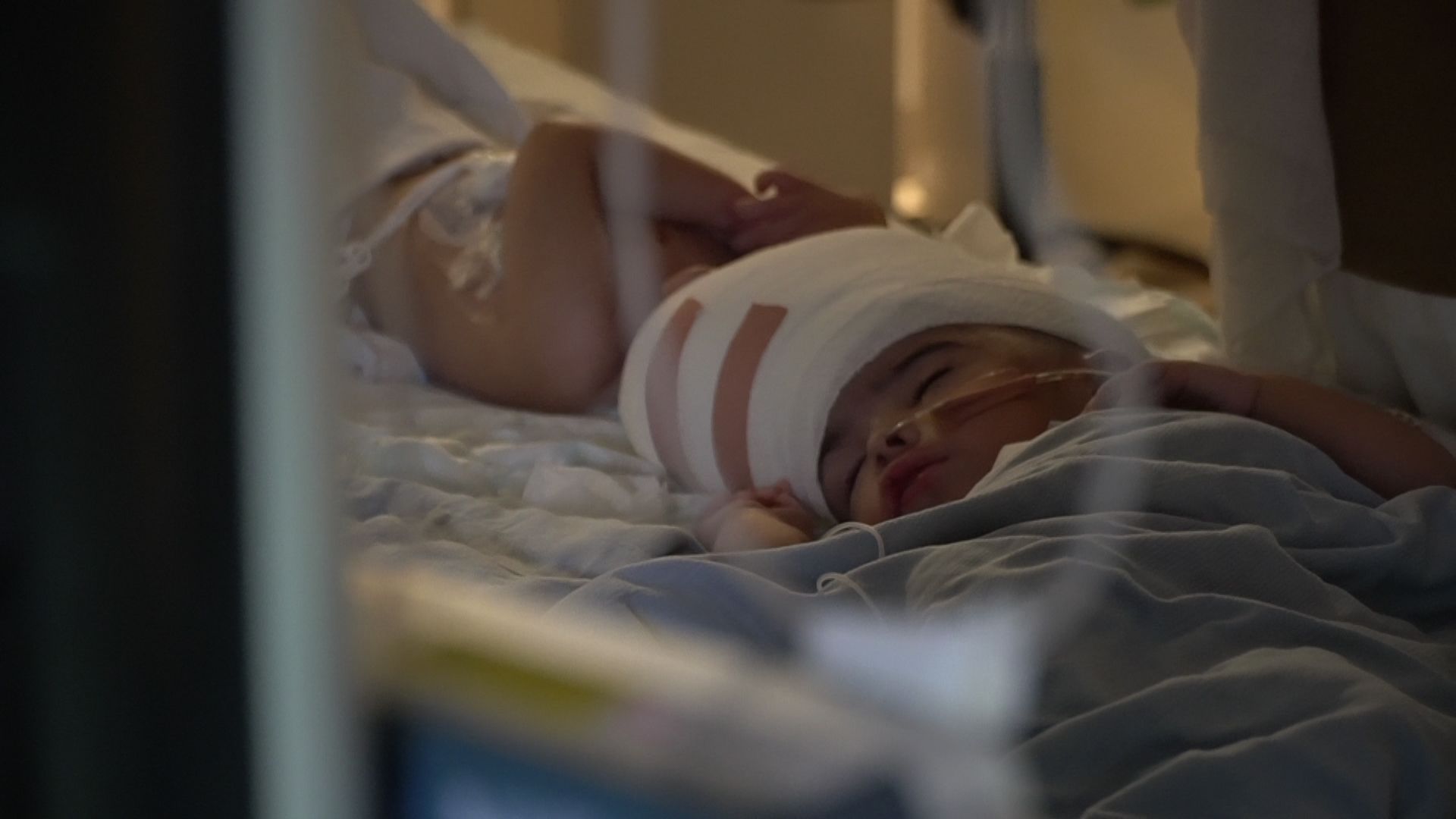


Creating new skin
Creating two round heads from the girls’ shared tubular anatomy presents a particular challenge. There isn’t enough surface area to cover the top of two heads once they have been split apart.
It’s January 2019, just weeks from the final separation. Plastic surgeons David Dunaway and Juling Ong are by the twins’ bedside, trying to solve one part of the problem - the lack of skin to cover their heads when separated.
Two weeks earlier, they had inserted four small plastic sacs under the skin of their foreheads and at the back of their shared skull, and these areas now look strangely lumpy.

The sacs are tissue expanders, and their role is to encourage skin growth.
“They have a tiny little port attached to them through which we can inject saline,” explains Dunaway. “The idea is that we will gradually inject the tissue expanders and they will blow up like a balloon and the skin over the top of them will stretch.”
They hope six weeks of skin expansion will give them enough extra surface to cover the tops of the girls’ heads.
Dunaway admits that the last couple of months haven’t been easy.
“It’s been a stormy time for Safa and Marwa,” he says. “They've had ups and downs with infections and temperatures, and Marwa's heart is having to work quite hard for both of them. That's causing her a few challenges. But they're hanging in there and are both reasonably well.”

David Dunaway fills the skin expanders with saline
David Dunaway fills the skin expanders with saline
Next for the girls will be the separation. For the first time in their lives they will be able to see each other.
Separation
The day of separation is brought forward by four weeks because Marwa’s heart is still struggling. It’s February 2019 - four months since the first surgery.
This is what the months of planning and preparation have been building towards.
The twins have already endured 35 hours of surgery from the two previous operations.
Over the next seven hours, the remaining connections of bone, brain and tissue are severed, until just one piece of dura, the membrane around the brain, links the sisters.
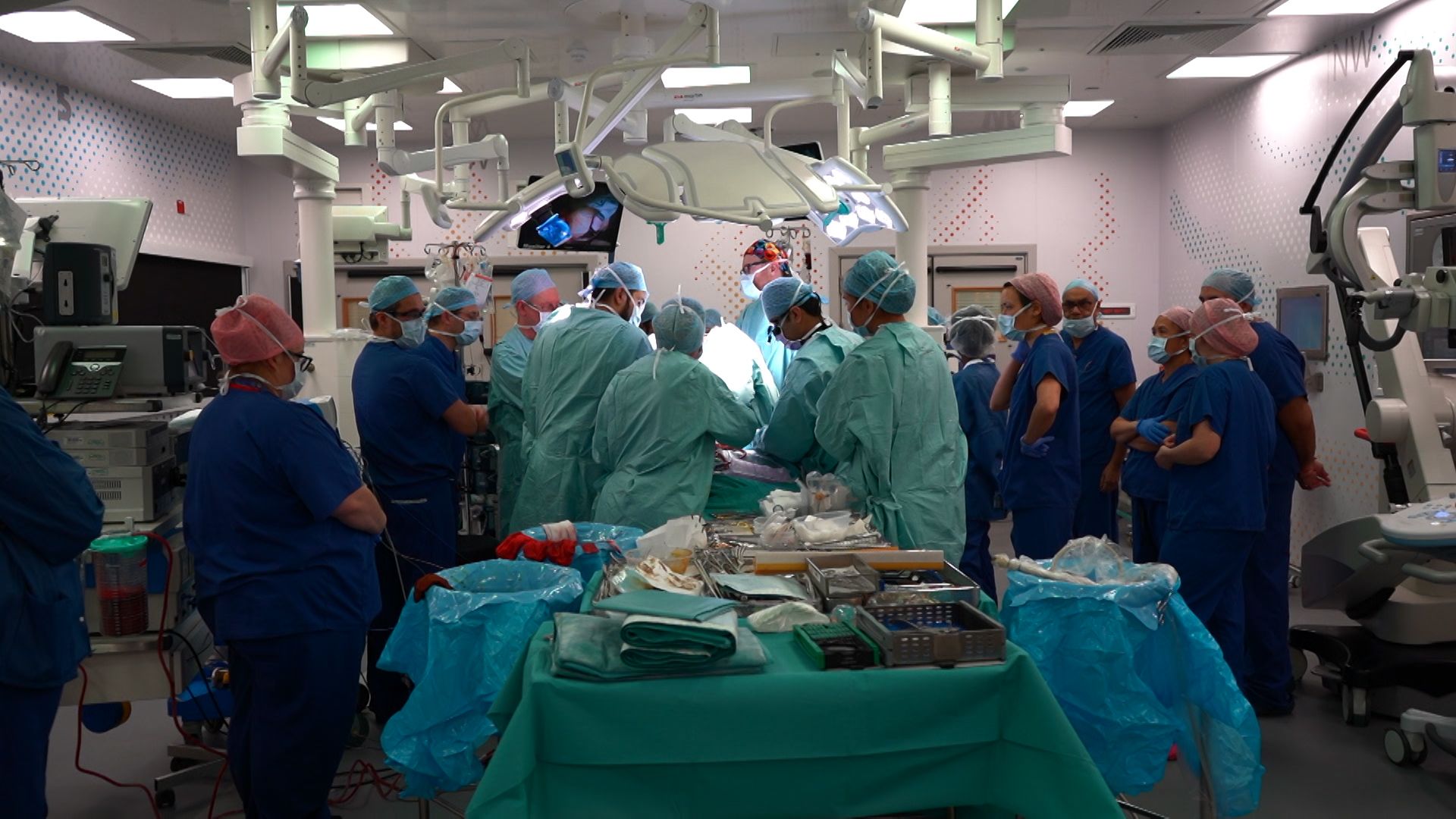

Then, the final connection is cut. Several members of the surgical team step in to gently lift the two fragile bodies apart.
Twins still, conjoined no more.
“Fantastic,” says Dunaway.
For the first time in their two years of life, the survival of each sister is no longer dependent on the other. That will make it easier for the two anaesthetic teams to regulate their heart rates, blood pressure and other vital signs.
But separation is only the opening act of today’s surgery. The team now has to shape a rounded head for each child, from the remnants of their shared tubular skull, and hope the extra skin they managed to grow will cover them.
Each twin now needs their own operating theatre. Half of the surgical team will stay with Marwa under the guidance of Jeelani and Ong, while Dunaway will head up a second team next door to reconstruct Safa’s skull.
Plastic film is used to wrap the top of her exposed head so she can be safely moved.
As the parallel operating rooms are prepped for the final stage, the two lead surgeons, smiling broadly, shake hands in the corridor outside.
“It was a very emotional moment,” says Dunaway. “We've been working a long time to get them here - they've been through so many operations and now it's worked.”
Jeelani adds: “We have taken the twins apart, but now we have to reconstruct their heads, and put each of them back together.”

The separation could not have gone ahead if the twins’ brains had remained misshapen.
By applying gentle pressure over the past four months, the surgeons have largely corrected the distortion, although the girls’ heads will always be slightly taller at the back. All that remains is to push the putty-like brains the last couple of centimetres into the newly divided skull cavities.
“Team Safa” and “Team Marwa” begin the painstaking task of skull reconstruction.
“A piece for me, piece for you, piece for me, piece for you," says Dunaway, a veteran of 23 years in plastic and cranio-facial surgery, making two piles of skull fragments.
To have enough skull to cover both heads, each fragment must be divided in two.
“The skull is usefully designed in three layers: the inner and outer layers are very thick tough bone, but in between is like a honeycomb so you can split it. It is half the thickness but it means we should be able to cover nearly all the head with bone,” says Dunaway.
With the girls’ brains enclosed in the watertight casing of dura, the skull fragments are jigsawed over the top of their now spherical heads. The individual pieces are secured in place with a lattice of disposable stitches, creating an archipelago of bone fragments.
The gaps have been seeded with bone cells, and in the coming months these should slowly close up leaving each sister with a complete skull.
The final task is to stretch the skin over the reconstructed skulls. There is just enough to make the join. Dunaway shakes his head in wonder. "Pretty amazing day isn't it?” he says.
At 01:30, after 17 hours in theatre, there is an emotional meeting between the two lead surgeons and the girls' family, who have been waiting in the hospital all day for news.
Speaking in Urdu, Jeelani tells Zainab that her daughters are finally separate.
Overcome, she kisses his hands and those of Dunaway.

Rital and Ritaj
While Safa and Marwa are slowly recovering in hospital in London, Jeelani and Dunaway take a trip to Ireland to visit Rital and Ritaj Gaboura, the craniopagus twins they separated in 2011, aged 11 months.
They are excited about seeing the girls, who will be nine in September, for the first time, at the family home in Cavan.
Their father Abdel-Majeed Gaboura is a doctor at a local hospital. His wife, Enas, trained as a psychiatrist in Sudan.


A slight asymmetry in their head shape is the only evidence that their skulls were once joined together.
The Gaboura sisters have had one of the most successful outcomes of any separated craniopagus twins. Born in 2010 in Sudan, the girls shared one long skull, but unlike Safa and Marwa their brains were not misshapen.
They arrived at GOSH aged seven months in a very poor condition. Rital’s heart was failing because it was being overworked, supplying blood to much of her sister’s brain as well as her own. Both twins would have died without surgery.
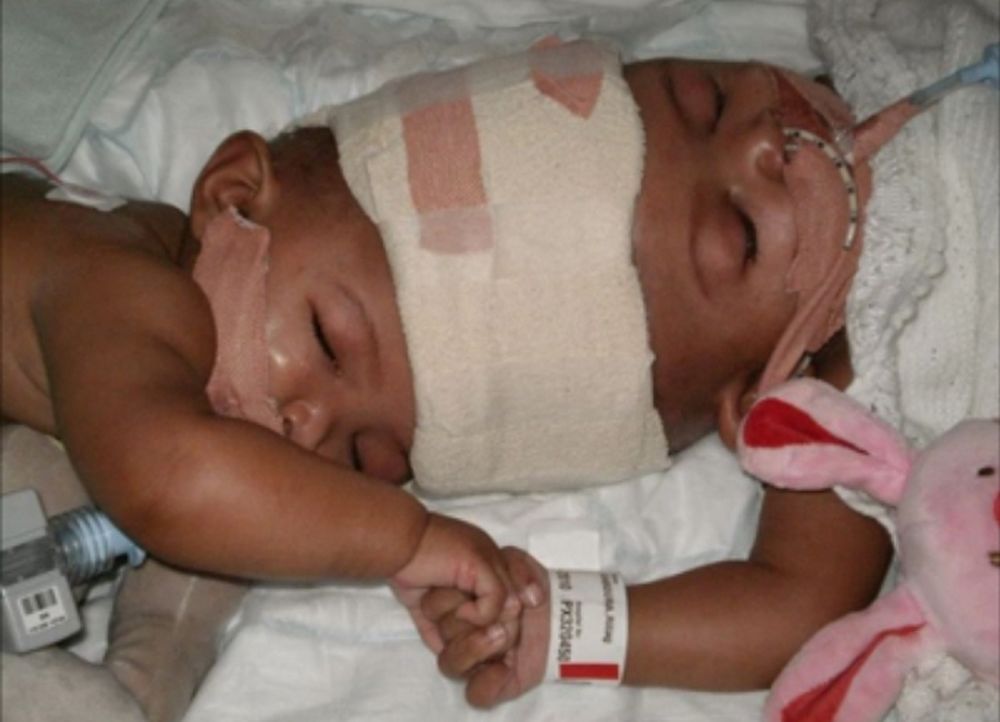
Their four-stage separation took place over three months, and within a few weeks they were recovering well.
Rital is on the autistic spectrum and goes to a special school, whereas Ritaj is showing typical development for her age and is in mainstream education.
The twins have a strong relationship. Ritaj is “the boss” according to their parents, who say they often ask for her help when Rital is being unco-operative.


Abdel-Majeed, says with pride: “I can’t even express my feelings that we are sitting here with two healthy twins, just as I had hoped at that time.”
Enas is pregnant again.
“It’s just one child, not twins,” she says with a smile.
“It was very different when I was pregnant before. I didn’t know if they would be born alive or dead.”
For the two surgeons it is an emotional meeting. “To visit the girls in their own home, settled in the community here, going to school, seeing their enjoyment in life and the family - that's a really very special reward. It tells us something about the value of this very rare surgery,” says Dunaway.
Rital and Ritaj are evidence of what can be achieved for craniopagus twins, if the surgery is done at a young age when the body’s regenerative powers are strongest. But the surgery is hugely expensive and that often means a delay in getting funding, which is what happened with Safa and Marwa.
Jeelani first spoke to their family when the girls were just three months old, but it took another 16 months to find a donor. He is convinced that delay affected the outcome.
“Had we been able to do them sooner, the results would have been better,” he says.
“They will have some long-term deficits, we envision that they will have problems with movement and intellectual function possibly. But we take the cue from the mother. She is delighted that we are where we are. She feels that they would have had no life had we not given them the chance.”
When carrying out such unusual operations, surgeons will always reflect on whether they did the right thing. But Dunaway knows life would have been arduous for the twins if they hadn’t been separated.
“It may have been difficult to provide the care to keep them fit and healthy. Clearly they are going to face some challenges but I think overall, it's a positive outcome for them. They have a chance of leading happy lives now.”
The two surgeons have set up a charity named Gemini Untwined to collate research and information on conjoined twins and help raise money for future operations.
“What we would like to see is that we don't have this potentially damaging delay in treating children, and a research arm giving us much more information,” says Dunaway. “There is so much we don't know about conjoined twins, we think we're doing it the right way but we really need to understand that in a scientific way.”
Recovery
The day of discharge has finally arrived for Safa and Marwa. It is nearly five months since they were separated and it’s been a long, slow recovery for the girls. Both needed skin grafts on the back of their heads. And they have been receiving daily physiotherapy to help them reach some basic milestones - learning to roll, sit and hold their heads up.
Their mum has dressed them in eye-catching red-and-gold outfits to celebrate the occasion. While Zainab packs up the last of their things, Marwa giggles and squirms on the bed as her grandfather tickles her.
Safa plays copycat with her uncle, taking turns to bang on a drum. There is still a long way to go but they are making progress and starting to regain their former playfulness.

When the time comes to leave, there are hugs and tears from mum and the nurses and doctors who have cared for them.
Dunaway pops in between cases to say a last goodbye, and Jeelani appears straight from the operating theatre just in time to walk them out. His strong bond with the family is evident and the pride he feels at seeing the girls recovered enough to be discharged is written on his face.
Safa, Marwa and their family will stay in London for the next six months at least, while the girls have more physiotherapy and checkups but their plan is to return home to Pakistan in early 2020.
As they leave the hospital that has been their home for the past 11 months, Zainab is clear that separating the girls was the right thing to do.
“I am very happy. With God's grace I am able to hold one for an hour and then the other one. God has answered our prayers.”
Credits
Authors: Rachael Buchanan, Fergus Walsh
Graphics: Joanne McDonald, Gerry Fletcher
Videos and photography: Tony Fallshaw, Julius Peacock, Rob Magee
Additional photos: Bibi family, Gaboura family, Alamy
Producer: James Percy
Editor: Kathryn Westcott
Publication date: 15 July 2019